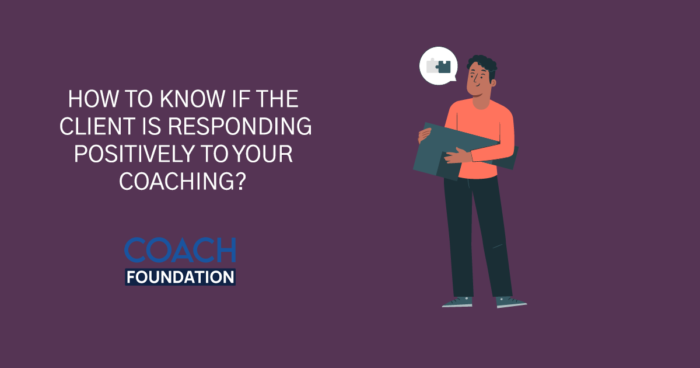Blog » Coaching Business » How To Know If The Client Is Responding Positively To Your Coaching?
How To Know If The Client Is Responding Positively To Your Coaching?
Coaching is most effective when based on precise, quantifiable, and time-bound objectives. These objectives must be rooted in a teacher’s professional practice and reflect the most effective ways of influencing student learning.
A suitable aim may be like this; Every week, employ a range of formative evaluations, and the information from those assessments will assist you in improving your coaching plans.

Alternatively, build positive relationships with your clients and survey results from them on how much they enjoy and learn in your coaching class.
This entails continuing documenting (by the coach) and evaluating experiences while implementing the actions that the client committed to following.
Knowing if your client is responding in your coaching session involves gathering data to evaluate the coaching’s performance and progress toward the desired changes and outcomes. Monitoring coaching efficacy makes it simple to determine whether circumstances have evolved or changed during the process.
Evaluation allows constant monitoring of all the client’s actions. When done regularly, it will assist you in answering questions about the coaching’s efficacy.
Adapting the following stages to the client’s requirements becomes a must. Monitoring a client’s development can help you increase your clients’ long-term success rate and the effectiveness of your coaching.
This data must be gathered systematically, structured, and routine in a shared environment to which both the client and the coach have 24/7 access. In coaching, process tracking can provide answers to queries like:
- What is the client’s current status? (execution, action, and implementation)
- Are we taking the proper steps? (any deviance, stumbling barrier, or failure to perform as planned)
- What effect has coaching had? (The client will be able to see her development and better understand the process.)
As previously said, your clients must communicate their views, experiences, and accomplishments with you all systematically and frequently. Sharing resources like a weekly coaching assessment form or a coaching effectiveness questionnaire is sufficient.
Before the next session, have your clients respond and share their thoughts with you. This may be unfamiliar territory for some of your clients. Still, after a few repetitions, it becomes a habit that trains and enhances their awareness and concentration on real-life events. The key to a good procedure is consciousness.
In Brief : How To Know If The Client Is Responding Positively To Your Coaching?
- Notice The Client’s Body Language – Observing client’s body language may involve training in nonverbal communication, potentially incurring training costs.
- Take Note Of The Client’s Word – Enhancing note-taking techniques may involve potential costs for training or tools to maintain eye contact while taking notes.
- Factor In The Client’s Tone Of Voice – Analyzing client’s tone of voice may involve training in communication skills, potentially incurring training costs.
- Watch The Client’s Energy Level – Monitoring client’s energy level may involve training in energy management, potentially incurring training costs.
- Observe The Environment Around The Client – Promoting awareness of the client’s environment may involve training in mindfulness techniques, potentially incurring training costs.
- Check If The Client Is Engaged And Asks Questions – Coaching on engagement and questioning skills may involve training in effective communication, potentially incurring training costs.
- Is The Client Taking Active Action On The Agreed-Upon Goals? – Assessing client’s active action on goals may involve providing surveys and resources, potentially incurring resource development costs.
- Is The Client Providing Feedback About Their Coaching Experience? – Gathering feedback from clients about their coaching experience may involve creating feedback systems, potentially incurring development costs.
- Check-In With The Client Regularly – Providing regular check-ins with clients may involve communication efforts, potentially incurring communication-related costs.
- Ask For Direct Feedback From The Client – Requesting direct feedback from clients may involve training in feedback solicitation, potentially incurring training costs.
What is coaching?
Coaching is a pattern in which an experienced individual, known as a coach, provides training and assistance to help a student or client achieve a specified personal or professional objective. The learner is also known as a coach. One has more expertise than the other and provides direction and assistance as the latter learns; however, coaching varies from mentoring. It focuses on key tasks or objectives rather than more particular goals or general improvement. Coaching can sometimes refer to a casual relationship between parties.
Coaching is a two-way street
It isn’t a one-way street when it comes to coaching. Rather, it’s a two-way street in which one side raises the knowledge of the other so that they might decide to change and better. The crucial factor could be to train employees on the importance of coaching to help steer the necessary employee-manager interaction.
How to check if the client is responding to your coaching sessions
When considering how to measure the efficacy of coaching, it’s best to begin at the start of the process rather than at the end.
While monitoring is normal and continuing, assessment is a critical and dynamic process or finished intervention’s implementation and outcomes. Tracking allows you to review the phases of your coaching process regularly, respond to your client’s condition and needs, and simply alter the following steps;
1. Notice the client’s body language
Observe where your client is looking, what motions they are making, how they are situated, or voice tone. The energy level they are exhibiting throughout a coaching encounter. All of these nonverbal indications will assist you in figuring out what they are feeling.
2. Take note of the client’s word
Writing huge letters and skipping lines is a good way to take notes while maintaining eye contact. Look at your page now and again to make sure what you’re writing is readable. If you’re using a tablet, be sure your fingers aren’t drifting to the wrong keys by looking down.
3. Factor in the client’s tone of voice
Your client’s voice tone explains and transmits meaning when you’re communicating with them. A basic sentence like “I don’t know” can be expressed in various ways.
4. Watch the client’s energy level
The coach has chosen to be more reserved. The coach should contact the client and monitor their energy level. The coach, not the client, is in charge of establishing the tone of the conversation. The consumer is enthusiastic about their education. The coach must confirm the client; however, the client has little duty toward the coach other than to guarantee that they devote the energy needed to the coaching being performed on them.
5. Observe the environment around the client
Bring attention to our surroundings and the season to create increased awareness of the physical world, and ask your coachee to notice and explain what is around them and how it is changing. Then encourage them to consider what is changing in their world for them. Ask your coachee to remain quiet and aware for a few minutes at the beginning of the session, and then ask them to explain what filled that space for them: did they sense their breathing, posture, body, and the noises around them?
6. Check if the client is engaged and asks questions
It’s a good idea to ask your inquiries and then wait patiently (great use of silence) for a response from the customer. This delay may have significant implications if the individual generally responds swiftly but only after a lengthy procedure to a specific inquiry. Not to mention that the client’s response’s paralinguistic features might disclose far more than verbal replies.
7. Is the client taking active action on the agreed-upon goals?
You may share surveys and resources with your customers to help them measure and analyze their coaching activities and how well they are achieving their objectives. This makes evaluating individual steps throughout a coaching session incredibly simple and efficient.
8. Is the client providing feedback about their coaching experience?
The client is not seen as a source of feedback in the expertise tradition. It lays a great deal of responsibility on the executive coach, who is supposed to provide excellent coaching seamlessly. A client’s passivity may result as a result of such an approach.
9. Check-in with the client regularly
You wouldn’t want to bother them by contacting them too much, but neither do you want them to neglect you. This is a judgment call; however, best practices appear to recommend that you should reach them at least thrice every three months ( i.e., once per qtr), but no more than once each month.
10. Ask for direct feedback from the client
Don’t waste any time if you want to know how you fared on certain coaching. It is preferable to inquire as soon as possible. According to Batista, it would help if you didn’t strive to cover everything in one talk. He recommends breaking it down into small parts and spacing out the conversations. You also don’t need to make an official approach or arrange time ahead of time. “Don’t conceive it as a formal meeting,” Heen advises. “All you have to do is contact (or use the social media platforms) your coachee and have a fast and casual coaching conversation.” A farewell inquiry for the client’s reaction to coaching might be a good way to end a conversation with them.
What steps can you take to ensure that the client is getting the most out of your coaching relationship together?
Make a list of your own goals before attending the coaching session. Allow your clients to express their desires. Many coaches start their sessions by asking clients to disclose their event goals. You’ll be surprised at how much more effective a coaching session becomes if you arrive prepared, interested, and receptive to new ideas. Your company has invested in you; now it’s time for you to match that commitment with your time and effort.
What should you do if you think the client is not responding positively to your coaching work with them?
- First and foremost, pay attention to what’s being said.
- Empathy is a great way to build rapport.
- Reduce the volume of your voice.
- Respond as though your whole consumer base is watching.
- Recognize when it’s time to give up.
- Keep your cool.
- Don’t take anything too seriously.
- Keep in mind that you’re dealing with a person.
Conclusion
During a session, coaches might employ a variety of engaging questions. Open-ended questions allow reflection and help the coach and client form a peer-to-peer connection. When used judiciously, close-ended questions can indeed be beneficial.
Coaching is a mostly unregulated profession. While some instructors have a lot of experience, some don’t.
Certification can be used to demonstrate a specific degree of expertise. However, this does not always imply that the instructor is a good fit for the client or has the appropriate expertise.
In addition, every coach may improve their strong questions during a coaching session. As a result, the coach can develop a more productive relationship with clients. In your coaching practice, make use of effective questions. Ask questions you think other coaches should ask.


ABOUT SAI BLACKBYRN
I’m Sai Blackbyrn, better known as “The Coach’s Mentor.” I help Coaches like you establish their business online. My system is simple: close more clients at higher fees. You can take advantage of technology, and use it as a catalyst to grow your coaching business in a matter of weeks; not months, not years. It’s easier than you think.
AS SEEN ON
0 Comment